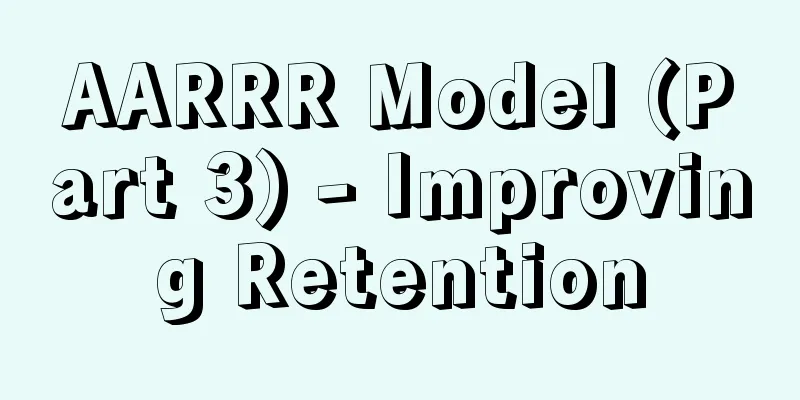AARRR Model (Part 3) - Improving Retention

One sentence definitionWill users continue to use our products? User performance at this levelDuration of use after first use Operational StrategyConduct targeted analysis on process issues and then come up with strategies Corresponding data monitoring1. Retention rate 2. Churn rate Next-day retention rate: (number of new users on the day who used the product on the second day) / total number of new users on the first day Day 3 retention rate: (number of new users on the first day who used the product on the third day) / total number of new users on the first day Retention rate on day 7: (number of new users on day 1 who used the product on day 7) / total number of new users on day 1 30th day retention rate: (number of new users on the first day who used the product on the 30th day) / total number of new users on the first day Daily churn rate: (number of users who logged into the app on the day of the statistics but did not log into the app in the following 7 days) / number of active users on the day of the statistics Weekly churn rate: (number of users who logged into the app last week but not this week) / number of active users last week Monthly churn rate: (number of users who logged into the app last month but not this month) / number of monthly active users last month IntroductionPeter Drucker once said: The purpose of business is to create and retain customers. Research shows that for every 5 percentage point increase in user retention, profits will increase by 25 to 95 percentage points. Conversely, this means that user churn will result in huge losses. The longer you retain users, the better you understand their needs and desires, and the more you can provide them with personalized services and advertisements, which will naturally make more money from them. Another benefit of a high retention rate is that it can make your word-of-mouth and viral marketing more effective, because the longer users use your product, the more likely they are to talk about it and even recommend it to friends and others. The most fundamental point to retain users is to provide high-quality products or services that can continuously meet their needs or make them happy, making the products or services indispensable to them. Retention can be divided into three stages: initial, mid-term and long-term. 1. Initial RetentionThe initial stage of retention is critical because this stage will determine whether users continue to use or purchase a product or service or become “dormant” after using it once or twice. You should decide how long your product’s initial retention should be based on the product’s industry standards and your analysis of user behavior. There is an advantage to early retention. Research shows that the more value users get from a product at this stage, the more likely they are to use it long term. And there are often many opportunities to improve the user experience at this stage. The initial retention phase is essentially an extension of the activation phase. You can think of it as ensuring that users are actually active, rather than just taking a look and then losing interest in the product. For this part, you can go to the previous article - "Activating Users" to review relevant strategies. Continuously optimizing the new user experience and allowing users to experience the core value of the product as quickly as possible are the two most important strategies at this stage. 2. Mid-term retention1. Let users develop usage habitsOnce users pass the initial retention stage, they enter the mid-retention stage. At this time, the novelty brought by the product begins to fade. To retain mid-term users, the core task of the growth team is to make the use of the product a habit and let users gradually gain satisfaction from the product or service. In this way, users will continue to use your product or service without encouragement, because it has become an integral part of their daily life. In general, the core goal of mid-term retention is to allow users to develop the habit of using the product, thereby consolidating their loyalty to the product. Daily active function: Daily active function refers to cultivating user habits through some methods; common methods include the sign-in function of various products, the first win reward function of game products, the daily energy acquisition function of Ant Forest, etc., all of which stimulate users to use products from the dimension of nature, so as to obtain monetary or spiritual gains and retain users. 2. Improve practical and experiential rewardsA principle that applies to most types of products is that increasing the value of rewards in the eyes of users can lead to greater retention. To make a product or service more habit-forming, the growth team should experiment with offering users a variety of rewards and encouraging them to take actions to earn them. The more actions users take, the bigger the rewards, and the greater the value of the rewards in their eyes. Rather than looking at rewards in terms of money or money saved, teams should experiment with rewards in terms of product experience. In fact, some of the most habit-forming rewards are intangible. In addition to offering users special offers and discounts, there are three other rewards strategies worth noting. 1) Brand Ambassador Program 2) Recognize user achievements 3) Personalization of customer relationships 3. Control the rhythmPromising users that new features are coming soon is a very powerful retention bait. Telling users that new features or products will be available soon and what benefits they will get can effectively induce users to keep using the product, but you must control the rhythm. 3. Long-term retentionAt this stage, the role of the growth team is to ensure that the product continues to bring greater value to users. The team must experiment with various methods to continuously improve the product and help the product development team decide when to upgrade existing features or launch new features. The most critical part of this stage is to make users constantly realize the indispensability of the product. 1. Enrich product content and improve product functions(1) Optimize existing product features, push, and reward repeat use; (2) Launch new features regularly over a longer period of time. It is extremely important to strike a balance between the two. Deborah Viana Thompson, Rebecca Hamilton, and Roland Last note that cramming too many features into a product often hurts long-term retention because “adding many features to a product in an effort to maximize choice can ultimately reduce customer lifetime value.” They conclude that “companies should consider having more products with limited but more specialized features, rather than trying to pack every possible feature into one product.” Growth teams can conduct experiments by providing users with product prototypes or trials to evaluate whether proposed new features are attractive. 2. Continuous user guidanceAs users become more and more proficient in using the product, they should be guided to start paying attention to features they have never used before and new features that have just been launched. This is a gradual process, and users must first master the old features before they can start learning new features. You can use the [User Growth System] to guide users. The user growth system reflects the product's expectations and appropriate guidance for user behavior, and provides certain incentives for user behaviors that are beneficial to the product; while harmful behaviors are punished accordingly. At the same time, the user growth system can increase user stickiness and improve user retention rate. Common user growth systems include points system, level achievement system, membership system, medal and title system, etc. We can flexibly design the user growth system according to product characteristics. The user growth system can encourage user behavior and make users feel recognized. It can also provide appropriate feedback of recognition to users on their behavior in the product, motivating users and forming a positive cycle. 3. Resurrecting “Zombie Users”The first step is to investigate why users are leaving in the first place. The simplest way to do this is to interview users who have canceled or stopped using your product and ask them directly why they left. This will help you figure out if the reasons people are leaving are controllable or solvable. The team should try to win back users by sending them emails or targeted ads that remind them of the product’s “aha moment” or the core value of the product that attracted them in the first place. Most importantly, you need to experiment with the wording, frequency, and duration of your messaging to ensure that your request to “come back” doesn’t annoy or further alienate your users, or you’ll simply make them think less of you and completely destroy any hope of winning them back. 4. Retention methods suitable for all three stages above1. Event OperationActivity operation is an operational means to achieve explosive effects by guiding user behavior in the short term, thereby achieving long-term product goals. For example, Bilibili’s incentive plan for financial creators will encourage financial creators to produce more high-quality content and gain more user attention in the short term; in the long run, the platform will have more high-quality financial content in stock, and content producers will have more fans, gradually realizing Bilibili’s long-term product goal of going beyond the circle. 2. PUSHPUSH is an important means for products to continuously reach users and recall lost users. PUSH needs to pay attention to the frequency, time and content of push; the push frequency cannot be too high, which will cause users to be bored. The time of push is generally in line with the user's product usage habits, such as when users just get up in the morning, commute, eat at noon, and browse information products before going to bed; of course, if the content is immediate and users will also care about it, it can also be pushed immediately, such as the latest news on the epidemic. Because push notifications are mainly text-based, an eye-catching title and a topic that users will care about are very important. The content of the push notifications also needs to be refined, and the title and topic should be continuously optimized to increase the user opening rate. 3. Strengthen user investment and increase "stored value"Strengthening user investment means using some methods to precipitate user behavior on the product so that users become dependent on the product. In this way, even if competing products emerge, users will not easily leave the product. Common methods include the following:
Author: Ju Yuejisan, an Internet operator, wants to bring you the "aha moment" on your road to operational growth. Source: WeChat official account: "Operator's Growth Notes" |
>>: AARRR Model (IV) - Increasing Revenue
Recommend
The basis of Douyin's sales is diligence
As a new e-commerce model, Douyin is becoming more...
Which Lazada site has the best traffic? How to choose?
If you choose cross-border e-commerce, you must ch...
How does Wish promote its products? Is the promotion effective?
As a world-renowned cross-border e-commerce platfo...
100,000+ exposures in 5 days! I use Douyin to attract customers for traditional enterprises, and the commission in a single month is over 80,000!
It is becoming increasingly difficult for enterpri...
After ordinary people make money, remember these 6 points!
In this article, the author shares six things that...
Kuaishou will no longer provide financial support to Station A by not renewing the contract with the UP host
Station A, as a control group of Station B, is now...
Only selling bucket noodles on Douyin, with sales of 1 million orders!
An account selling bottled noodles shot more than ...
What are the steps to apply for Amazon VAT? Amazon VAT application process
The most important thing for cross-border e-commer...
How to place Amazon ads? Related questions answered
More and more merchants are opening stores on Amaz...
Why don't these Japanese companies do marketing? They sell their products all over the world
During his visit to Japan, the author solved a puz...
Redefine "consumption attributes" and your products can be sold at a higher price!
When people judge the value of a product, they wil...
How to quickly register on shein? Registration review process
With the rise of cross-border e-commerce, Shein ha...
Heytea is competing for the Paris market, Yili is “buying shares in advance”…are these “fancy ways” of Olympic marketing?
The 2024 Paris Olympics is about to kick off. Its ...
How to register in Shopee Taiwan? What are the requirements?
Shopee platform is developing rapidly and has grea...
Michelin restaurants sell poor person set menus. Is high-end dining still a good business?
Michelin restaurants have also started selling &qu...









